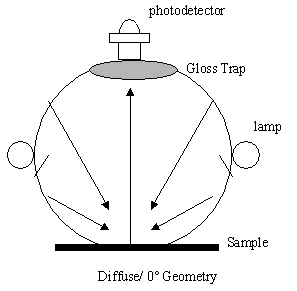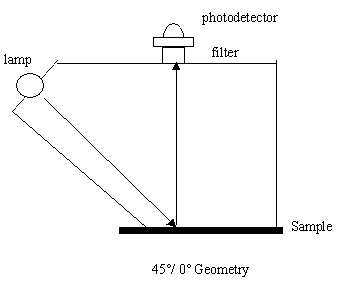Brightness testing, as it is performed by Kodak, is the reflectance of blue light (a specific spectral distribution with a principal wavelength of 457 nm). We make readings in this wavelength because it coincides with lignin absorption. Lignin is the "glue" that holds fibers together and can give paper a yellow tint. The brightness value shows the bleaching quality in in the pulp of the paper.
There are different standard methods of measuring brightness. The following standard tests are frequently used test methods in the paper industry.
T525 | Diffuse brightness of pulp (d/0deg) |
T452 | Brightness of pulp, paper, and paperboard (directional reflectance at 457 nm) |
ISO 2470 | Paper and board measurement of diffuse blue reflectance factor ISO brightness |
ISO 2469 | Measurement of diffuse factor |
You can see the differences between brightness tests in the geometry of the tester: Below, you see two configurations used in brightness testing.
 |
The Diffuse / 0° Geometry works this way:
Two lamps shine in an integrating sphere.
The sphere causes light to bounce around and lights the sample diffusely.
A photodetector located perpendicular to the sample plane records the light coming from the paper surface.
The Directional Brightness Tester has one light that shines at 45[ordm ] to the sample.
 |
When looking at diffuse vs directional brightness, itis important to know:
Since brightness testing is the measure of reflectance of blue light, brightness measurements are also affected by the presence of optical brighteners. These brighteners absorb ultra-violet radiation and emit light in the blue region of the visible spectrum. Therefore, the amount of ultraviolet radiation that strikes the sample affects the resulting brightness of the paper. Use of different sources/illuminants changes the ultraviolet amount as well as the visible spectrum.
Kodak uses a diffuse brightness instrument that conforms to ISO 2469 (Paper, board and pulps measurement of diffuse reflectance factor). Kodak uses ISO 2469 for test equipment parameters. The brightness test is a variation of ISO 2470 (Paper and board-Measurement of diffuse blue reflectance factor (ISO Brightness).
Brightness measurements depend on:
Whether you are using a diffuse or directional brightness tester.
The amount of ultraviolet radiation that strikes the sample.
The amount of brightners present in the media.
The composition of the media.
Brightners fluoresce with ultraviolet light and emit light at visible wavelengths. We can see the emitted light with our eyes and this can influence how we perceive the media.
